There is an old saying that whoever has visions should consult a doctor.1
With Building Worlds. Visionary Architecture in the 20th Century the Archiv der Avantgarden – Egidio Marzona, Dresden, employ the visions of 20th century architecture as the basis for a probing examination of both the built environment and the condition of contemporary architecture.......
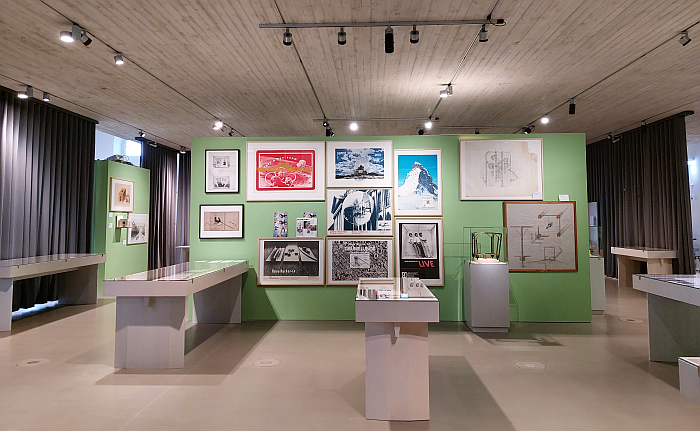
Formally opened in May 2024 in a reworking by Nieto Sobejano Arquitectos of the so-called Blockhaus, a work on the right bank of the Elbe, the Dresden Neustadt side of the Elbe, with views over Dresden Altstadt, a so-called Blockhaus originally from the mid-18th century that over the intervening decades has undergone several reworkings, the Archiv der Avantgarden – Egidio Marzona comprises some 1,7 million objects donated to the Staatlichen Kunstsammlungen Dresden by the eponymous gallerist and publisher Egidio Marzona. An archive that understands itself as not just a location for research but also for discourse and mediation. The latter including via exhibitions, and following on from Archive of Dreams. A Surrealist Impulse, Building Worlds. Visionary Architecture in the 20th Century is the institution's second exhibition.
An exhibition that develops its narrative via the works, positions and approaches of some 10 international creatives/creative practices that chronologically spans from a Bruno Taut in the earliest years of the 20th century, a Taut discussed in close association with the author Paul Scheerbart, a friend of Taut's who not only penned fantasy and science fiction works but was also an advocate of glass architecture in an age before glass architecture was a thing, to collectives established in the heady atmosphere of the 1960s, including London's Archigram and Vienna's Haus-Rucker-Co and Coop Himmelb(l)au, the latter two, practices with their myriad inflatables and perception and environment altering machines.
Two Austrian practices joined by the native Austrian, naturalised American, Raimund Abraham, who is represented by several projects including his mid-1960s Living Capsules, a Moon based project which, one can argue, reinterprets, recycles, the various domes of a Richard 'Bucky' Buckminster Fuller one also meets in Building Worlds; a reinterpretation of Bucky's domes that can also be found amongst the projects presented by Ettore Sottsass, if a use by Sottsass that is much more critical of Bucky's domes than Abraham's reinterpretation.
And an Ettore Sottsass who is one of three Italian practices featured in Building Worlds alongside Superstudio with their articulation of the Radical Architecture (and design) of the 1960s, and by the professional and personal partnership of Leonardo Mosso and Laura Castagno-Mosso who, as one learns, were early pioneers of and protagonists for the use computers in architecture.
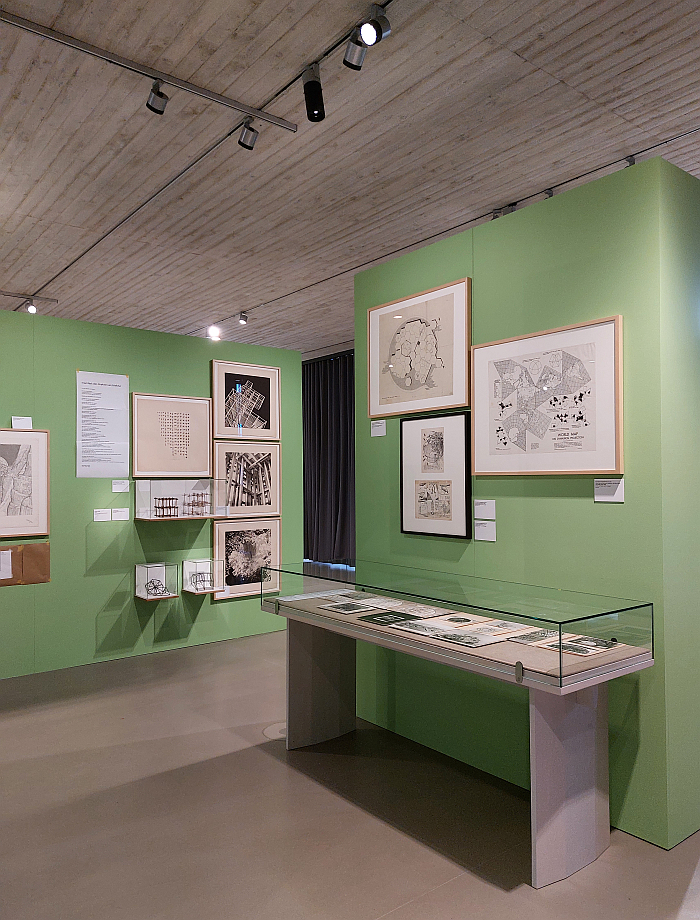
A dectet of creatives expanded by the chapters Networks which, if one so will, reinforces the interchange and discourse between the works, positions and approaches of the dectet that can be followed and reflected upon in Building Worlds and also expands the scope of that interchange and discourse through introducing the likes of, and amongst many others, Hans Hollein, David-Georges Emmerich or Guy Dessauges; and Alternative Architecture which aside from introducing various 20th century criticisms of contemporary architecture also brings the vernacular, architect-less, realised and maintained built environment into the discussion. A vernacular that, as one can observe in Building Worlds, influenced and informed aspects of the work of a Sottsass or a Taut. And we'll argue also a Bucky: as discussed from Shape of Dreams. The Architecture of Witold Lipiński at the Muzeum Architektury, Wrocław, not only is the house of the future always as round as Bucky's domes, but the vernacular houses of a great may global peoples and cultures are and were also as round as Bucky's domes.
An exhibition not only within the Archiv der Avantgarden but that comes from within the Archiv der Avantgarden, from the institution's own collection, save two chapters, two invited/commissioned chapters which expand on that in the Archiv der Avantgarden and also expand on the works by the featured dectet, on the contribution of the dectet to the initiated dialogue: We Are Millennium Stars, an installation by Maja Wirkus and Eric Pries which we've not seen as it was yet to be installed when we were there, but which, if we've understood correctly, concerns itself with Modernist architecture in Poland and questions of the legacy of Helena Syrkus, one of the leading protagonists in and of Modernism in Poland; and Makedonium by Hristina Ivanoska and Yane Calovski, which we have seen, and which concerns itself with the so-called Ilinden Memorial, or Makedonium, in Kruševo, North Macedonia, and in particular the role of the sculptor Iskra Grabuloska in the project's development. And a Makedonium that reminds that, and as discussed by and from The Gift. Stories of Generosity and Violence in Architecture at the Architekturmuseum der TU München, 1960s and 70s Skopje, capital of the, then, Socialist Republic of Macedonia, was a important location for visionary architecture in context of the international response to the earthquake that devastated the city in 1963; visionary architecture that for all it is today most popularly associated with the monumental Metabolism of a Kenzō Tange covers a wide rage of genres and contexts.
As does Building Worlds.
Thereby enabling it to be a presentation that for all it is without question the presented projects and creatives, also employs the works approaches, positions of the featured creatives as a conduit for reflections and considerations on the Visionary Architecture of its title.
¿Reflections and considerations on Utopian Architecture?
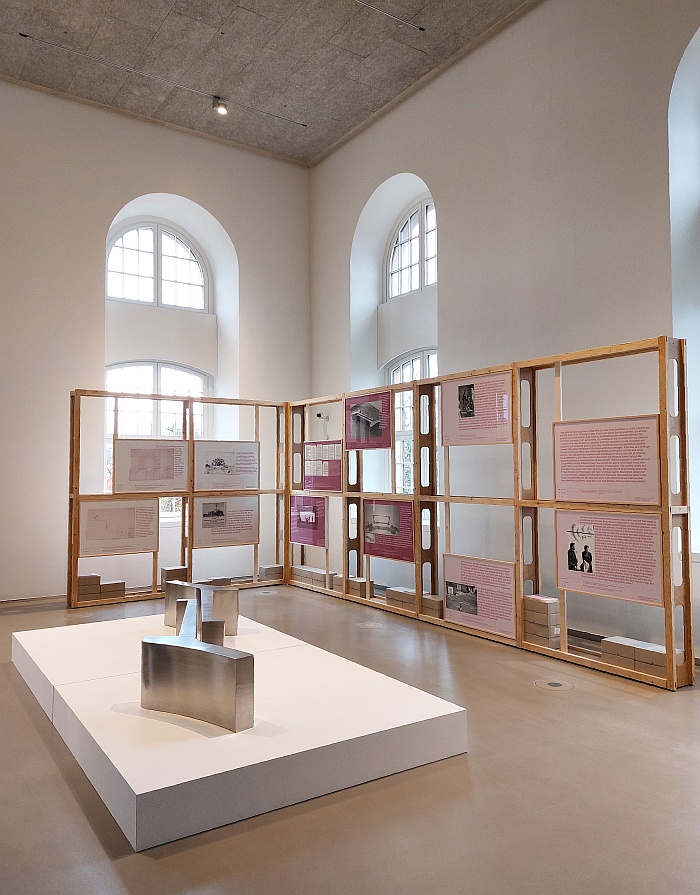
We travelled to Dresden very much assuming it was going to be. Left Dresden unsure.
But then before visiting Building Worlds we'd probably never actively considered what we meant by 'utopian'. Just used it. Much as before viewing Everything at Once: Postmodernity, 1967–1992 at the Bundeskunsthalle, Bonn, we'd simply used the term 'Postmodern'. And now don't. The Archiv der Avantgarden's use of Visionary in the exhibition title, and, primarily, the projects selected and presented, forced us to begin that questioning of our use of 'utopia', not just in terms of architecture, but generally. And that not least because whereas 'utopia' is properly translated as 'no place', 'no land' or 'nowhere', it is most commonly understood as being 'a perfect place', which, technically, is its homophone, eutopia, which as EUtopia is a term well worth juggling with, provides hours of entertainment and is more meaningful than inanely scrolling through your Instagram feed, but we digress....... whereas 'utopia' is properly translated as 'no place', 'no land' or 'nowhere', it is most commonly understood as being 'a perfect place', and as the latter there is very much an implicit inference of a better society, of a better quality of life. As the former there isn't that implicit inference; however, in Thomas More's early 16th century description of the island of Utopia, from which we have the term, and the confusion on its meaning, the land described was, in More's argument, better than the reality of early 16th century Europe. Thus 'utopia' always has a hint of a better society, of a better quality of life.
While many of the projects in Building Worlds do imply a better society, imply a better quality of life through changing how we develop the built environment, changing relationships with the built environment, not all do, thus, we'd argue, on the basis on the current state of our thinking, while evoking John Ruskin to reserve the right to change that opinion at least three times, not all can be considered 'utopian'. But all do challenge convention, propose novel methods, novel processes, novel approaches, novel positions that conventional thinking, that conventional appreciations of the nature of, and interdependency of, individuals, society, the natural environment and the built environment simply couldn't arrive at, all demand a change in how we approach the questions of the built environment, and thus, we'd argue, on the basis on the current state of our thinking, can be considered visionary.
In addition several of the projects imply, admonish, warn, that 'utopias' always, but always, become 'dystopias', that thing we as species are simply unable to learn; not just in terms of the built environment but that we fall for every snake oil seller that crosses our path. And then are shocked when the Metaverse, ear buds, social media, delivery drones, autonomous cars, et al, don't make everything better, but make everything differently bad. When that 'utopia' we were promised remains the unattainable, non-existent thing 'utopia' tells it is. Or would tell us it is if we didn't all read 'utopia' as 'eutopia'. Words are important. Even in a primarily visual society with a 10 second attention span.
A risk of a plan going awry that visions share with utopias, if, arguably, with a vision it isn't as inevitable as with a utopia. But still very resent. Risks as can be witnessed a few meters down the Elbe from the Archiv der Avantgarden where the remains of the Carola bridge protrude from the water as a reminder of the contemporary reality of the visionary use of concrete in the 1960s/70s. While the interruption to the ship transport on the Elbe caused by the collapse reminds of the wider damage imploding visions, and imploding 'utopias', invariably have. That the consequences are always felt far beyond their immediate vicinity.
A collapsed concrete bridge, a collapsed vision, that you can view on your way to (and from) the Archiv der Avantgarden that also allows you to question what remains of the 20th century projects featured in Building Worlds in our 21st century.
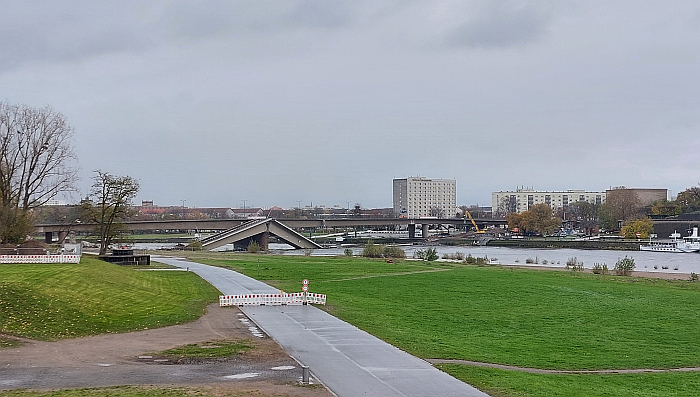
Physically very little. Bruno Taut, for example, never did realise his proposed rebuilding of the alps, never did fuse the natural world with the human built world as he envisaged in his various Alpine Architecture projects which one meets in Building Worlds; Archigram never did realise their proposed Plug-in-Cities, never did transform cities into interconnected networks of readily exchangeable modular elements suspended in an external framework; Superstudio never realised their Monumento Continuo, never did construct a raster that circumnavigated the globe as the basis for a novel built environment. Arguably alone Bucky's domes physically remain. And the inflatables and perception and environment altering machines of Haus-Rucker-Co and Coop Himmelb(l)au. Though not in contexts, or use scenarios, as their authors intended.
However, as Building Worlds allows one to appreciate, conceptually a great deal remains, that much as there is an interchange and discourse between the works, positions and approaches of the projects on show, that interchange and discourse is very much ongoing: visions for the Alps as a built environment may have turned to the tourism included in Ois Anders: Major Projects in Bavaria 1945-2020 at the Haus der Bayerischen Geschichte, Regensburg, but considerations on fusing the natural world with the human built world continue, albeit a more harmonic, equable, mutualistic fusion than the brutal intervention in the natural by the human built Taut proposed; we may still not have the serial construction that Archigram predicted, and that we genuinely do need, and which 3D printing may bring us, but we are slowly learning to both embrace modularity as the basis for responsive systems, despite the negative connotations so many make in context of the visionary architecture that dominates so much of post 1939-45 War urban planning in Dresden, and also appreciating that transforming, recycling, the existing built environment is very much preferable to the continually replacing it previous generations delighted in. A contemporary appreciation of the value of (re)construction via recycling within the existing framework rather than a deconstruction and reconstruction of a framework that is, arguably, at the core of what Achigram proposed; that what Archigram proposed was 1960s building recycling, was conceptually was a far as one could think then. And not only is and was Superstudio's Monumento Continuo a concept that, as discussed by The Tube. An Architecture for Conceivable Times at the Werkbundarchiv – Museum der Dinge, Berlin, itself a moment in a long (hi)story, pun intended, of visionary and utopian linear constructions, but it finds an echo today in Saudi Arabia's Line. A vision, we'll argue a 'utopia', waiting to go monumentally awry. And all will be amazed when it does. Wow! We'll all say, why did that not work?
Continuations, re-imaginings and repositions of many of the projects in Building Worlds that help reinforce that the Visionary Architecture of the exhibition title, in both its development and its realisation, is intimately related to perceptions of contemporary society and to appreciations of the relationships between humans and the planet we rely on, and also exists in context of novel technology and novel materials, one of things things that, as discussed from Konstantin Grcic. New Normals at Haus am Waldsee, Berlin, or Back to Future. Technology visions between fiction and reality at the Museum für Kommunikation, Frankfurt, means ideas are often around for ages before becoming reality: because they simply can't be realised at the moment of their conception. Which doesn't mean they have to be realised once the materials and technology catch up, see flying cars and AI (em)powered robotic butlers; and also means that if they are realised once materials and technology catch up then that needs must be differently to when they were conceived, because society has moved on from where it was.
Thoughts on materials and technology, and on materials and technology catching up with architectural visions, that is very present in Leonardo Mosso and Laura Castagno-Mosso's use of computers, including their 1968/9 Manifesto dell’architettura diretta, Manifesto of Direct Architecture, in which they not only argue for a greater integration of computers in human life, at times it reads like a Manifesto for AI, but which demands an "architecture that is programmed in an indeterminate way, not because it is formless, but because it is infinite in the variability of its essence"2, thoughts on 1960s contemporary computer technology enabling an infinitely variable architecture which remind of the arguments by and from The Architecture Machine. The Role of Computers in Architecture at the Architekturmuseum der TU München that contemporary digital technology allows architects to create forms, geometries, that not only would have previously been undrawable, but which traditional masonry and carpentry, and also the reinforced concrete of a Pier Luigi Nervi or an Ulrich Müther, would struggle to produce. But we can 3D print them. Or should be able to.
Thoughts on the work of Leonardo Mosso and Laura Castagno-Mosso in a contemporary context that also highlights a further aspect of contemporary architecture (and design). As does We Are Millennium Stars and Makedonium.
The women missing from the (hi)story of architecture (and design).

Over a great many decades the work of Leonardo Mosso and Laura Castagno-Mosso has been popularly recorded and discussed as the work of Leonardo Mosso; similarly the Makedonium has long been discussed as a work by Jordan Grabuloski. According to the curators, in the research for Building Worlds the contribution of Laura Castagno-Mosso became increasingly visible. And in the development of their Makedonium project, a project that has developing for some 4 years, and is ongoing, Hristina Ivanoska and Yane Calovski have, through archival research, demonstrated the central contribution of Iskra Grabuloska to the Makedonium.
That (hi)story forget both Laura Castagno-Mosso and Iskra Grabuloska is, arguably, not just on account of the male, male-centric, view on, and writing of, the (hi)story of architecture but also because of the oft discussed in these dispatches situation whereby females in professional/personal creative partnerships only rarely record what they do when they do it, meaning that when historians turn up, with their conditioned male-centric reading, they simply don't see the females. Can't see the females. See also, for example, Lucia Moholy or Lilly Reich.
Similarly unseen is Helena Syrkus, despite the fact that she was for a great many years a Vice President of the Congrès Internationaux d’Architecture Moderne, CIAM, that network of international architects founded by, and over many years dominated by, Le Corbusier, that was so influential in the development of architectural theory and practice. And a Helena Syrkus who was a defender of avant-garde architecture in a Poland that largely didn't want to know. Which doesn't appear to have stopped her developing her positions and theories; positions and theories she regularly discussed and debated with international colleagues, and, we presume, with her students in context of her tenure as Professor at the Politechnika Warszawska, many of whom invariably took up those positions and theories, developed them and thereby integrated them into the built fabric of the contemporary Poland. A built fabric Syrkus, (very) occasionally, was allowed to directly contribute to. ¿But where is Helena Syrkus is the narrative of the (hi)story of architecture?
A question that aside from being one about the (relative) anonymity of females in the (hi)story, the (his)tory, of architecture (and design) is also, along with the biography of Iskra Grabuloska, a reminder of the (relative) anonymity of eastern Europeans in the (hi)story of architecture (and design), that the (hi)story of architecture (and design) is primarily written with a western focus, from a western perspective, with western protagonists. And thereby also helping enable access to questions of the problem of intersectionality in the writing of the (hi)story of architecture (and design), that theory that those subjected to more than one prejudice have it even harder, that as an eastern European female architect or designer active in a previous generation you are less visible today on the helix of architecture (and design) (hi)story than a western European female architect or designer active in a previous generation. Both of whom are less visible than males.
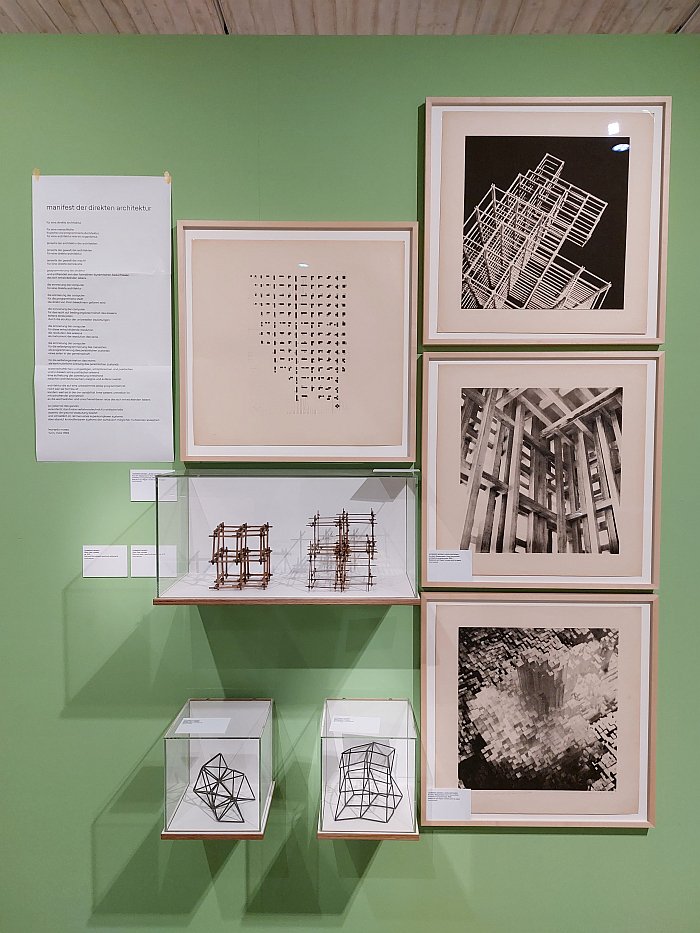
Thereby a presence of Laura Castagno-Mosso, Iskra Grabuloska and Helena Syrkus in Building Worlds that helps elucidate the amount of work that needs must still be undertaken in order to, as Vera Sacchetti and Matylda Krzykowski demanded at the Kunstgewerbemuseum Dresden, Add to the Cake of creative (hi)story and enabling the writing of the more probable narrative of the (hi)story of creativity in Europe that we all require, not least to allow us to better understand contemporary Europe.
And a presence of Laura Castagno-Mosso, Iskra Grabuloska and Helena Syrkus that is, are, good examples of what one can find in an archive when you view any archive with open eyes, with critical, questioning eyes, and not with the established conventional viewing that archives are normally approached with. Demonstrates how important an unbiased reading of any archive is; and that an archive must be read, not just catalogued, stored, and kept dust-free. Archives can't build worlds but they can allow us to approach an accurate reconstruction of worlds that once were, but only if used properly. And actively. And widely.
And only if collected properly. Whereas, if one so will, galleries are the traditional gatekeepers of the contemporary, decide who is heard in contemporary creative discourses, archives are the gatekeepers of the past, allow voices to be heard long after the physical body has perished, with, and as discussed in context of Regard! Art and Design by Women 1880–1940 at the Bröhan Museum, Berlin, all the responsibility that brings with it to be aware of how one collects, to be aware of the potential biases and skews in your collection processes that could lead future generations to face the challenges in reconstructing the past, certainly the pre-20th century past, that we do. And while the rescuing of Laura Castagno-Mosso from an unjust bit part is to be welcomed, the fact she is the only female in the Archiv der Avantgarden part of Building Worlds should, must, be questioned. ¿Is the gender mix in the presentation representative of the reality in the 20th century? ¿Or representative of a skew in the collection? We no know, we neither know the collection in detail nor have we encyclopedic knowledge of 20th century architecture. But the question must be posed. Of all archives. And by all archives. We're not picking on the Archiv der Avantgarden. Just using them as proxy.
Thus Building Worlds is as much an exhibition about what an archive is, can be, should be, must be, as much as one about visionary architecture of the 20th century.
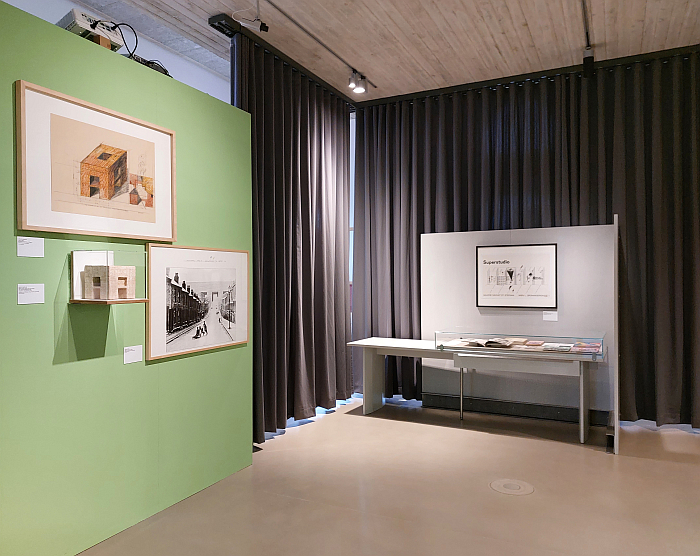
Small in space, expansive in scope, much like the inflatables of Haus-Rucker-Co and Coop Himmelb(l)au, Building Worlds is primarily based around theoretical and speculative projects and as such primarily unfolds its narrative via sketches, texts and montages, a format which, yes, does require a lot of input, time and effort from visitors, but, and as always in such cases, that's good. To be welcomed.
Not least because it means that much as Building Worlds is about the importance of reading archives it is also about the importance of reading theoretical and speculative architecture; is a presentation that admonishes that while it's very easy to read the projects on show in a superficial, objectified manner, that's unhelpful, it's not the what but the how, why and wherefore that should be your focus. Bucky's domes physically exist, cool!!: but how, why and wherefore do the exist? ¿So that Raimund Abraham can place them on the moon, and Ettore Sottsass can mock them?
A predominance of theoretical and speculative projects, and an admonishment to read beyond the superficial that also allows for a comparison between the visions of the presented creatives and science fiction, that other synonym for alternative futures that while often eutopic, needn't be, and are often very aware of the inevitable slide into a dystopia of any and every eutopia.
A comparison with science fiction, and the presence in Building Worlds of the aforementioned Paul Scheerbart, that enables differentiated reflections on the state of affairs discussed from Science Fiction Design: From Space Age to Metaverse at the Vitra Design Museum Schaudepot, Weil am Rhein, that a lot of synthetic plastic furniture design from the 1960s and 70s is discussed today as if it was influenced by the space exploration of the period, discussed as 'space age design'....... except it wasn't really, it was informed by novel materials, novel technology and novel demands on furniture by the novel society of the period. Which just happened to coincide with a period of space exploration. Thereby allowing for very lazy comparisons which marketeers are and were very keen to exploit.
A lot of the projects in Building Worlds are directly informed by the space exploration of the 20th century, play out in space, bring space back to Earth, remove any boundaries between the terrestrial and the extraterrestrial. But would we call them science fiction? And if not why not? Do we view them differently because they are the visions of architects, not of authors, or of designers? Do we view them differently because there are no marketeers involved? Do we view them differently because over the years they've not been repeatedly presented in variety of media as an unavoidable future towards which we must move? And celebrated as such. Do we view them differently because while we're comfortable relating to visions on a small, personal scale, were less comfortable with visions at the architectural scale? Do we view them differently because we're more discerning and critical with visions at the architectural scale than visions on a small, personal scale? Why do want flying cars and AI (em)powered robotic butlers but not Haus-Rucker-Co's Oase No. 7 or Bruno Taut's Alpine Architecture?
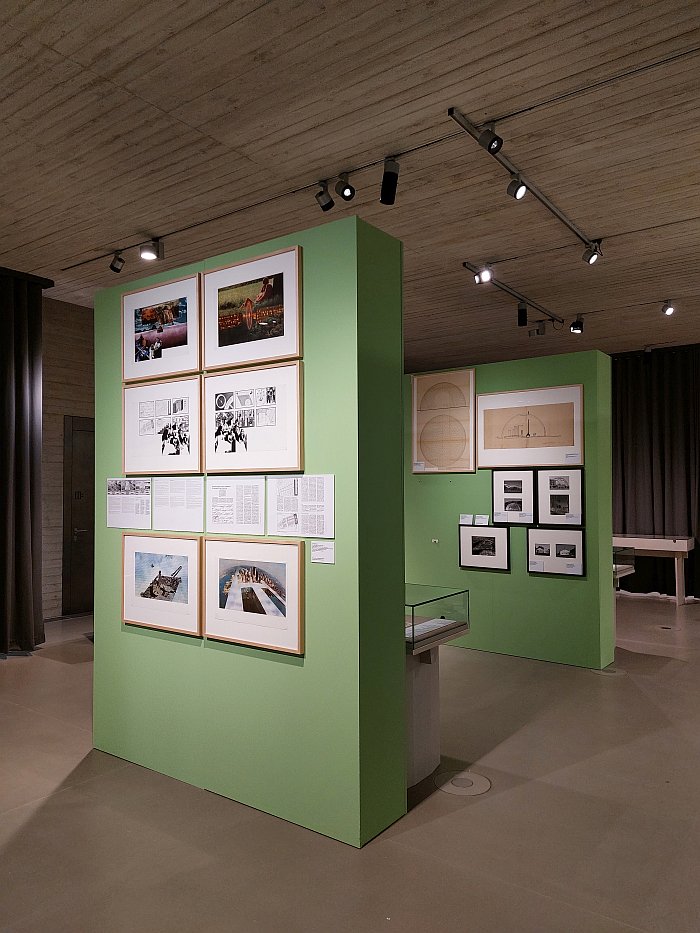
A predominance of theoretical and speculative projects that allows one to appreciate how over the course of the 20th century definitions of architecture developed, how the projects, and creatives, on show contributed to expanding not just space but definitions of architecture: whereas in days of yore architecture was the fusion of art and civil engineering that can be enjoyed as you gaze from the Archiv der Avantgarden across Dresden Altstadt, in the course of the 20th century architecture moved from the built environment to relationships within the built environment, and to relationships of the built environment with the natural environment and the individual inhabitants: as discussed from and by Profitopolis or the Condition of the City at the Werkbundarchiv – Museum der Dinge, Berlin, the built environment became a social environment, became as much about social engineering as civil engineering, or arguably the definition of 'civil' of 'civil engineering' has increasingly encompassed the fuller definition of 'civil' and not just its original 'non-military'. And the built environment became an environment with all the complexity that entails. A development of architecture away from the civil engineering and art it once primarily was that very naturally poses the question what is an architect in the 21st century? Who are architects? A question that, and at the risk of sounding like a Joseph Beuys we don't necessarily want to sound like, tends to cause one to move towards an answers that we are all architects.
And a predominance of theoretical and speculative projects in Building Worlds that also allows one to approach reflections that while theoretical and speculative architecture can be visionary, physical, built, architecture can't be truly visionary as long as construction is harmful, selfish and unsustainable. Built architecture can never be visionary if it is arrogant and believes itself to be the answer and celebrates its author.
Thereby making Building Worlds an exhibition that questions not only what an archive is, can be, should be, must be, but what built architecture is, can be, should be, must be, and in doing so tends, certainly for us, to argue that architects, or however we call them in the future, shouldn't build, shouldn't be allowed to build, but should propose, should theorise, that we very much need 'architects' with visions, very much need Bruno Tauts, Richard Buckminster Fullers, Raimund Abrahams et al, and always will, but that they should present their visions, and then leave wider society to translate that proposition, that position, into a reality. Or assign it to an archive. Where later generations may discover it and adapt it to their society and realities, an unknowable future society and realities where materials, technologies and appreciations of the relationships between humans and the planet we rely on may have caught up with the vision, may enable a meaningful translation of the vision.
That 'architects' should have visions, please do, but rather than seeking out a doctor, or heaven help us a PR agency, they should seek out a public discourse, seek a public consultation on their vision.
Building Worlds is very much an invitation for us all to pick up our stethoscopes and not only seek to diagnose the condition of the contemporary built environment, but also to make a prognosis on the future condition of the built environment, and thereby contribute to the formulation and administration of the necessary treatment.......
Building Worlds. Visionary Architecture in the 20th Century is scheduled to run at the Archiv der Avantgarden - Egidio Marzona, Blockhaus, Große Meißner Straße 19, 01097 Dresden until Sunday March 9th.
Further details, including information on the accompanying fringe programme, can be found at https://archiv-der-avantgarden.skd.museum
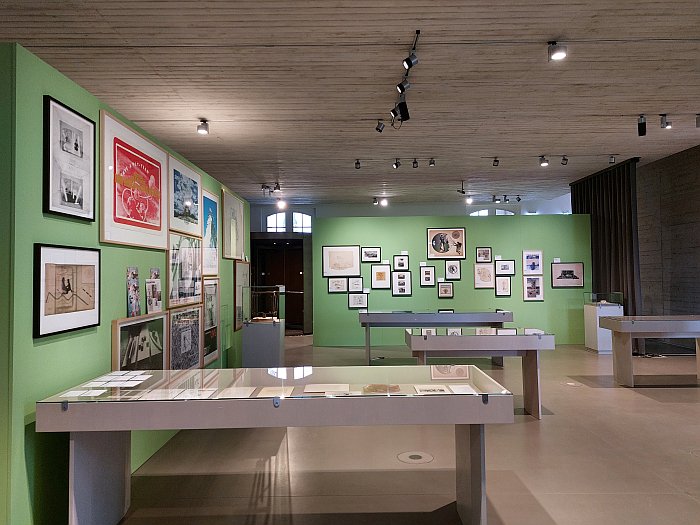
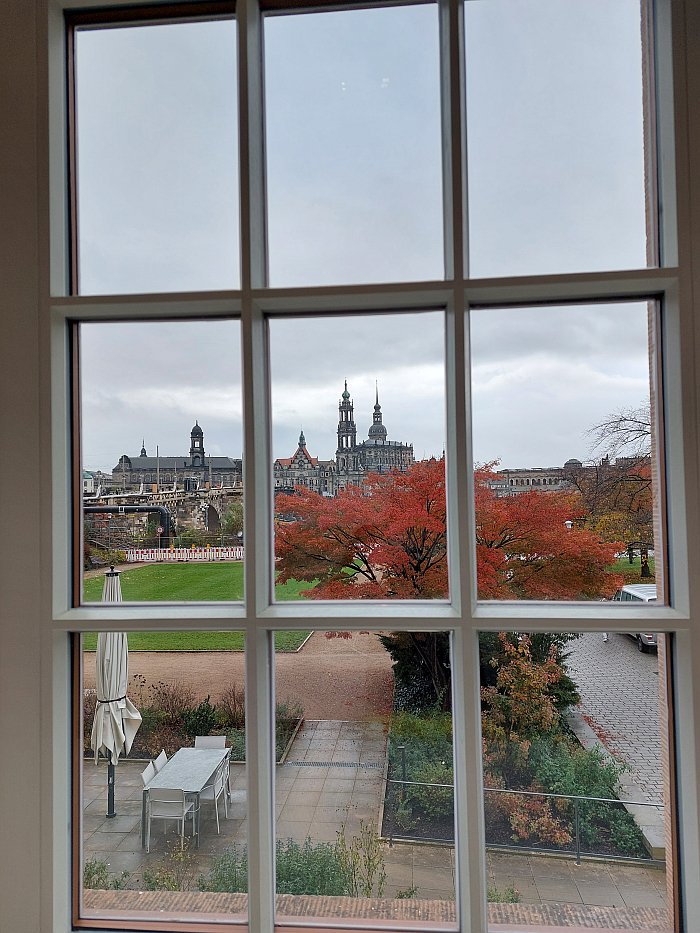
1Popularly attributed to the former German Chancellor Helmut Schmidt, Wer Visionen hat, sollte zum Arzt gehen, we are however, currently, unable to track down the original, which is apparently in a 1980 edition of Der Spiegel. Thus we are also not aware of the context, it may have been an insult, apologies if it was.
2Our translation from the German presented in Building Worlds. We've, again, been unable to find the original Italian. But very much hope to. Soon.